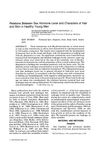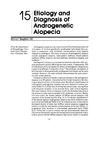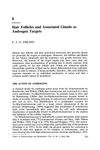 18 citations
,
May 1992 in “American Journal of Biological Anthropology”
18 citations
,
May 1992 in “American Journal of Biological Anthropology” Higher androgen levels do not cause baldness in men.
177 citations
,
June 1991 in “The Journal of Clinical Endocrinology & Metabolism” Caucasian men have more chest hair and higher levels of certain androgen products than Chinese men.
22 citations
,
July 1990 in “Acta Dermato Venereologica” High levels of testosterone and dihydrotestosterone inhibit hair cell growth, while high levels of estradiol promote it.
100 citations
,
April 1990 in “The Journal of Clinical Endocrinology & Metabolism” The ovary mainly causes high testosterone in PCO, while the adrenal gland is the main source in IH.
 1 citations
,
November 1989 in “PubMed”
1 citations
,
November 1989 in “PubMed” Male-pattern baldness is a natural process with unclear causes, and while Minoxidil can help, the results often aren't satisfactory.
16 citations
,
August 1989 in “Human Reproduction” Hirsutism in females is caused by high male hormones or sensitive hair follicles.
51 citations
,
November 1988 in “The Journal of Clinical Endocrinology & Metabolism” Higher levels of a specific hormone are linked to more chest hair and acne in men.
 5 citations
,
October 1988 in “Clinics in Dermatology”
5 citations
,
October 1988 in “Clinics in Dermatology” Minoxidil promotes hair growth but exact mechanism is unknown.
 9 citations
,
October 1988 in “Clinics in Dermatology”
9 citations
,
October 1988 in “Clinics in Dermatology” Hair loss is caused by genetics and hormones, diagnosed through examination and biopsy, and treated with medications or surgery.
9 citations
,
December 1987 in “European journal of endocrinology” The treatment significantly reduced hair growth and male hormone levels in hirsute women.
66 citations
,
October 1987 in “The Journal of clinical endocrinology and metabolism/Journal of clinical endocrinology & metabolism” Measuring androstanediol glucuronide in blood is useful for assessing and tracking treatment in women with excessive hair growth.
32 citations
,
May 1987 in “The Journal of Clinical Endocrinology & Metabolism” Salivary testosterone is a better measure for hirsutism than serum testosterone.
22 citations
,
May 1986 in “Clinics in endocrinology and metabolism” Certain finger length ratios and body hair patterns may predict side effects from birth control pills in women.
29 citations
,
May 1986 in “Journal of Steroid Biochemistry” Androgens don't directly affect hair cell growth or protein production.
 46 citations
,
May 1986 in “Seminars in Reproductive Medicine”
46 citations
,
May 1986 in “Seminars in Reproductive Medicine” Testosterone and dihydrotestosterone affect hair growth, and new techniques like the folliculogram help study it, but fully understanding hair growth is still complex.
 53 citations
,
May 1986 in “Clinics in endocrinology and metabolism”
53 citations
,
May 1986 in “Clinics in endocrinology and metabolism” Androgens like testosterone affect hair growth and oil production differently across body parts and individuals.
179 citations
,
May 1982 in “The Journal of clinical investigation/The journal of clinical investigation” High levels of 3 alpha-diol glucuronide in the blood are a marker of increased androgen action in women with excessive hair growth of unknown cause.
 7 citations
,
January 1981 in “Springer eBooks”
7 citations
,
January 1981 in “Springer eBooks” The document concludes that hair biology is complex and there are still unanswered questions about hair loss and follicle changes.
35 citations
,
January 1981






